https://public.tableau.com/app/profile/faihaa.khan/viz/Book3FinancialSuccessofFilms/Story3 (Click here for better view)
Project 2- The Quantified Self: Examining Part of My Sweater Collection
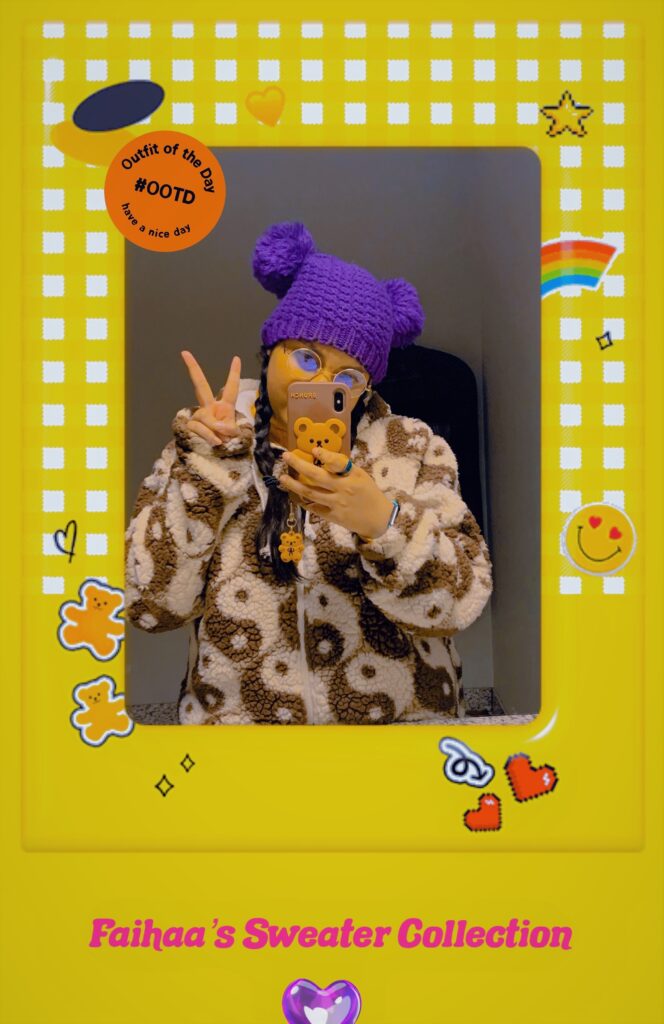
INTRODUCTION
When beginning to address the concept of the quantified self for my project I looked back at the material aspects of my life that I tend to ruminate on the most. The end outcome came down to clothing. This is something that I focus on frequently when it comes to organization. In my everyday life I organize my clothes in segments according to season and time. When the weather changes winter articles get packed away in favor of lighter fabric garments. And when things start to feel too small or have been worn out over time I set them aside to either donate or dispose of. For this project however I have decided to focus my organization through a different lens. This time I wanted to shift my attention over to details I don’t usually account for. By doing this I will have data and visualizations that will help me decide what I already have and don’t need more of as well as help me be more aware of where my clothing is coming from and what style I tend to gravitate towards the most.
RESEARCH QUESTION
My research question was based around my extensive sweater collection (the article of clothing I wear the most) and centered around the aforementioned query’s I wished to interrogate. These are the specific questions I based my visualizations on.
1. What are the specific styles of the sweaters (Sherpa, collared, hoodie, zip up and graphic)
2. Where are the sweaters made?
3. Was the sweater purchased online, at a store or was it second hand?
These questions will hopefully help me create correlations to distinguish how I classify my sense of style.
AUDIENCE
Because I inserted my own self made data and subject into this project the primary audience is me. However I feel that my data may also be of interest to those that are fascinated by visualizations utilizing the quantified self. Perhaps those that are also looking to organize their sweater/clothing collection may get inspired by the infographics.
DATA USED
My data consisted of me wearing a different sweater each day for 24 days. This is the number that I deemed to be sufficient enough for multiple visualizations. Each day I took a picture to help me remember what specific sweaters have been worn. Once I had all 24 pictures I made 2 set collages. Using photo edit pens in different colors I took note of the particulars I wished to investigate in accordance to sweater type. For country the garment was made and details of whereabouts, I made a list on my notes app featuring both. The data collected then went into different excel sheets that was then imported into Tableau as separate files. I felt that this was the easiest way to go about this as filtering different data ended up confusing the system and quite frankly me. Below are the photo collages I made. (Color Key for Sweater Type Red-Sherpa, Blue-Collared, Yellow-Hoodie, Green- Zip Up, Purple-Graphic, Pink-Other or None of the above)
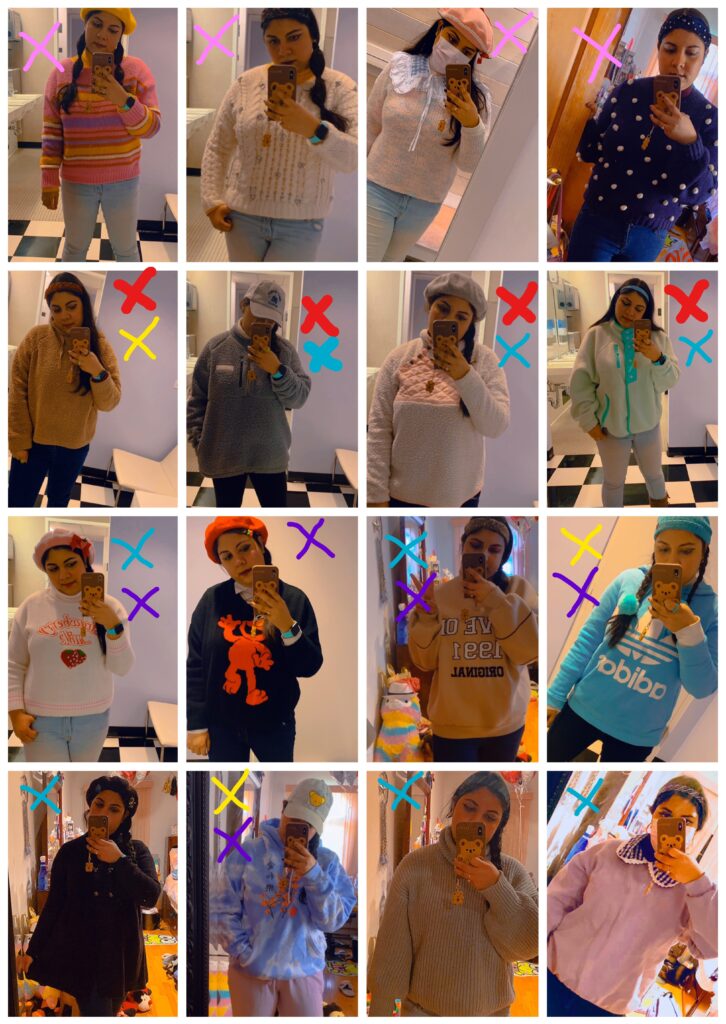
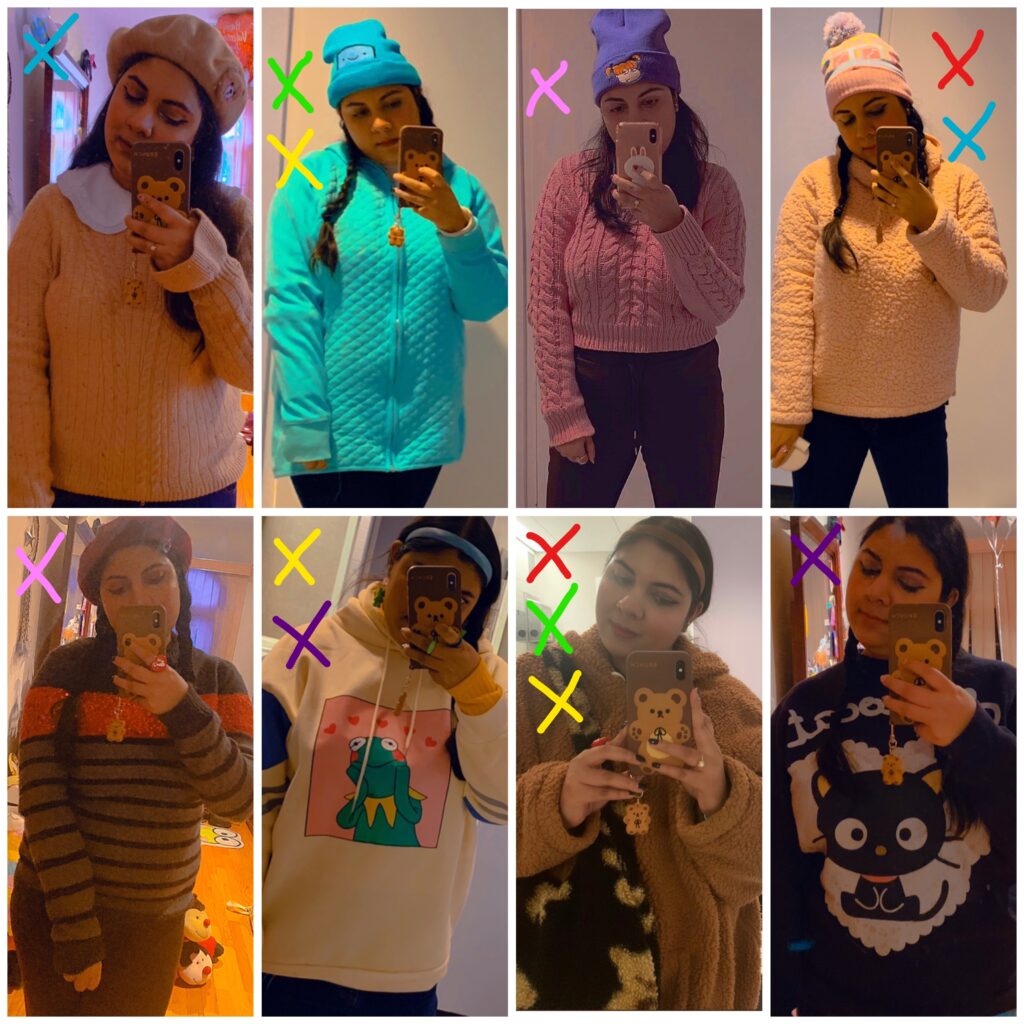
VISUALIZATION 1 (BAR GRAPH/S)
Sweater Collection Bar Graph | Tableau Public (Link for Better View)
(Click on image to activate hover over feature)
https://public.tableau.com/app/profile/faihaa.khan/viz/SweatersPerDesignType/Dashboard1 (Updated chart)
My first visualization was the most simple and straightforward. Using the the colored x’s on my photo collages, I counted how many sweaters fit into each design type and created a bar chart. I felt like this was the best graph to showcase a solid number count of data. However because a single sweater fit into multiple categories my bar charts are non exclusive. This is another reason as to why I chose a bar graph. The sweaters can still be separated even though they’re being counted more than once. My first chart separates each category on the x -axis while the y-axis presents the number of sweaters that fit in to each descriptor. According to my results I seem to favor collared sweaters the most although this is the category that I accounted for the most since turtlenecks also technically count as a collar. Surprisingly graphic, hoodie , Sherpa and other all had the same value of 6. For my second bar chart I decided to separate categories into mixed descriptor values. These were decided upon how many of the most mixed combinations were apparent in my data. This was my attempt to break down my stats even further. Both of these graphs together brings me to the conclusion that collar has definitely been my go to choice concerning sweaters.
Limitations- The mixed results in my bar graph makes it a bit difficult to discern the sweaters separately. The viewer will not be able to tell which category each sweater belongs to unless they take a look at my data set. This could present a problem if someone is looking for precise results.
VISUALIZATION 2
My second vis displays data on the origin of my sweaters i.e. In store, Second hand & Online. For this information I felt a pie chart was the best option. In making this infographic I made a list of the sweaters that I have worn and noted the bracket they belong in. Once I’ve done that I hand counted the number of sweaters in each bracket and imported the information in Tableau. From there I changed the numeric value to percent of total. The use of a pie chart was inspired by the ring pie chart used in Pris Lam’s “My Netflix Binge Fest”, which I personally felt was a good way to visualize 3 separate groupings. I’m aware that pie charts aren’t always the best to showcase data but in this case I feel it work’s fairly well. Without having to count through all my sweaters again I can tell that most sweaters were purchased in store with a whopping 63%.
Limitations- My percentage totals are taken from the whole sum of 100. I’m wondering if these would of made more sense to the viewer if I had put a whole number value instead. The pie chart also restricts the amount of info I can display. Although I’m satisfied with the graph because it tells me exactly what I need to know, the general bareness of the visual is a bit off putting.
VISUALIZATION 3
Sweater Collection Map | Tableau Public (Link for better view)
(Click on image to activate hover over feature)
For my last visualization I decided to do a map to illustrate where my sweaters were made. Initially I wanted to do a dot density map separated by continents but my data quickly revealed that most of my sweaters were made in China. In order to avoid the cluttered image of multiple dots in one region, I decided to display the countries of origin separately and indicate the number of sweaters made in each country by size. Each country is also indicated by a different color and highlighted to make the points extra clear. The hover over feature shows the number of sweaters per country listed. Aside from various garments being made in China the size of the dots also exhibit that Pakistan and Honduras also have multiple sweaters.
Limitations- I personally feel maps are best used when there’s a large amount of data to work with. Quite a few of the countries on my map only feature one sweater. Perhaps if I had more sweaters for each this would be a more intriguing visual.
Next Steps
In all I feel like I went the simple route when it came to my graphs. This may not necessarily be a bad thing but if I were to continue with this quantified self visualization I would be a bit more nuanced with what I am trying to uncover in my data. Or I’d simply just expand on what I already have. Perhaps a stacked bar chart layered combining design type combinations and design type would of been more interesting or multiple pie charts comparing sweaters in each category in accordance to the details in my bar graph. One thing for certain is that I would definitely build on my data set. I have way more sweaters than I’m showing here so if I had the time I would of most definitely added more!
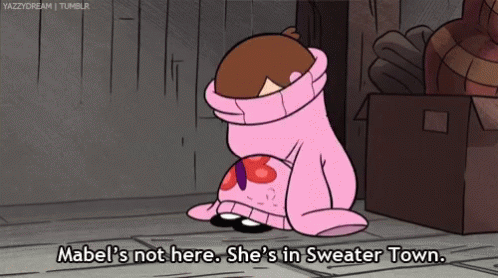
Project 1- Unsanitary Condition Complaints (Pre, During & Post Lockdown Year)
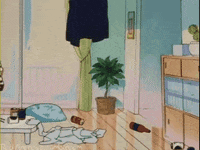
Introduction
In spring of 2020 NYC was known as the epicenter of the Covid -19 pandemic in the US. With a new instilled fear of a deadly/contagious disease many of us were obligated to stay in our homes under lockdown to prevent further spread and medical reports and news articles advised the public to increase hygienic practices to ensure safety. With the city in a health crisis and the citizens of New York forced to live their day to day lives inside their houses and apartments, one might assume that the prospects of escalated anxiety over unsanitary conditions had thoroughly increased. Is it possible that the existence of a pandemic along with forced isolation preempted New Yorkers to be more hyper aware of unsanitary conditions in their neighborhoods and home? That is what I attempted to find out through my visualizations. In my search I found data collected between 2019 (pre-lockdown) to 2021 (end of lockdown, vaccines available to all ages). Data found will evaluate the types of complaints New Yorkers are filing under unsanitary conditions.
Research Questions
1. How many complaints were filed by each borough in 2019, 2020 and 2021?
2.What types of complaints are being filed under Unsanitary Conditions in each borough and each year?
3. Will a comparison of the three consecutive years show evidence of the increase of complaints in households and neighborhoods during the Covid 19 lockdown in NYC?
Audience
My visualizations will help health/housing departments in NYC evaluate which issues need to be tended to the most in each borough. Furthermore, data collected can also be of use to those searching for a suitable neighborhood to live in NYC. Basically the results aggregated can provide context for both those residing in the NYC area as well as those that work to ensure the health and safety of others.
VISUALIZATION 1
My first visualization showcases the number of unsanitary condition complaints made by each borough in the years 2019-2021. The x-axis represents the numerical value of complaints while the y-axis displays each borough separated by color. The individual segments for each borough constitutes the year the complaints were made, starting from 2021.
A bar graph was the most clear cut way to show this data as Tableau was able to distinctly separate complaints by year and borough. The added color feature allows for users to distinguish each district on the y-axis and the scroll feature on each segmented year shows the exact number of complaints per year in the most straightforward way.
Through this visualization one can clearly see that the Bronx had the most number of unsanitary condition complaints in each year with the most number of complaints being filed during post lockdown 2021.
-The least number of complaints are filed by Staten Island in all 3 years with the most complaints filed also in post lockdown 2021.
-With the exception of Brooklyn and Queens, all other boroughs decrease in complaint number by descending year. (Brooklyn filed more complaints in 2019 than 2020 & Queens filed more complaints in 2020 than 2021)
Takeaway- Health/Housing Department should direct more of their attention towards the Bronx due to the vast amount of unsanitary conditions reported in the area. Considering the Bronx is not the largest nor the most populated borough in NYC this data is concerning. In accordance to my own personal research question involving the fear of Covid I can observe that the bulk of complaints happened in the post year of the Covid lockdown. Perhaps the need for outside help was stifled during the lockdown as many individuals avoided the need for workers to come inside their homes at the risk of spreading or catching the disease.
Limitations- I wish I was able to separate years by color as well. The hover feature is easy to use, but a color coded differentiator would of made results more clear and would allow the graph to work as a static image as well.
2nd Visualization
Book1 311 Unsanitary Condition Complaints (2019-2021) | Tableau Public (Link for better view)
My next graph shows the type of unsanitary complaint being filed along with the number of cases that coincide with it. The x-axis again represents numerical value while the y-axis represents borough and created date. Segmented bars feature borough, complaint descriptor, year and number of cases.
I chose to do another bar graph as this was the best way to efficiently picturize the data. I again used the color feature tool but this time I separated segments by descriptor. The palette I assigned had the most distinctive shade choices, which prevented the possibility of two or more colors looking to similar on screen.
This graph shows that the most common complaint filed under Unsanitary Condition is Pests. This is showcased across all boroughs and years.
-Second most filed complaint across all boroughs and years is Mold.
– Sewage is pictured as the least in every borough except Staten Island
Takeaway- NYC Health/Housing Department should be more hyper aware of pests and mold problems in the NYC area. Both of these categories can lead to health risks. Pests can carry vector-borne diseases and mold may trigger allergic reactions. Mold has also been known to carry mycotoxins in extreme cases.
In accordance to my hypothesis, I detected that the most common complaint seems to be particularly linked to household issues. Going back to the first bar graph that showed that most complaints were filed in 2021 I can deduce that the aforementioned possibility of individuals not wanting outside individuals to come inside their homes during lockdown holds some merit. Maybe the rise of complaints in 2021 is due to NYC residents feeling its safe to start enlisting outside help again. This is of course merged with the hyper-awareness of household issues prompted by the lockdown.
Limitations- I’m not fond of the size of the map when it’s imbedded into this post. Not sure what happened but the scroll feature makes it harder to read. Additionally the inclusion of unclean condition and unsanitary condition felt unnecessary and just end up crowding the color key.
3rd Visualization
Book1 311 Unsanitary Condition Complaints (2019-2021) | Tableau Public (for better view)
My final graph is a specific breakdown of unsanitary complaints by borough and lockdown year. X-axis represents number of complaints and y-axis displays borough, complaint type (descriptor) and coinciding year. A different color is associated with each descriptor.
I decided my third visualization to be a continuation of my second one, but this time I wanted to clean up my data and only show the descriptors recognized by the 311 data set. The complaints collected from 2019-2021 fell into 4 categories Garbage/Recycling, Mold, Pests and Sewage. The 5 boroughs are listed from most complaints filed to least and category of complaints are listed from lowest to highest. Once again a color key is in place to separate descriptors.
– This graph emphasizes previous information attained which reveal the Bronx as the borough filing the most complaints and Pests as the most filed complaint.
Takeaway- Remains the same from the previous visualization.
Limitations- Although I think the bar graph option displays data in a clear and easy to understand way I feel that the aesthetics of the graph looks a bit clustered. The y-axis seems a bit overcrowded but I’m not sure what to omit as all info is needed to get the full picture.
Next steps: In the future I think it will be interesting to see the socio-demographic, economic and geographical components that comprise each borough, specifically targeting the Bronx. A deeper dive into data may lead me to the precise neighborhoods these complaints are taking place and if the city is doing anything to aid in the manner. Once I have that information I will connect back with the pandemic to see how individuals in lockdown felt being trapped in their households, homes that appear to be riddled with unsanitary conditions.
-A more specified breakdown of timeframe would also be more helpful. A Certain date range may reveal more information.
Data Visualizations/Projects for DATA 73000 – Data Visualization

